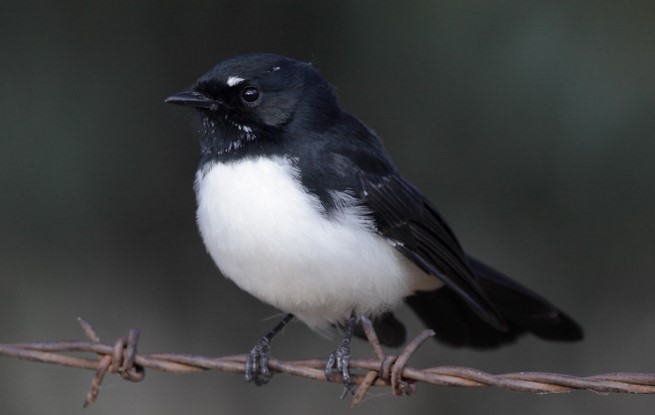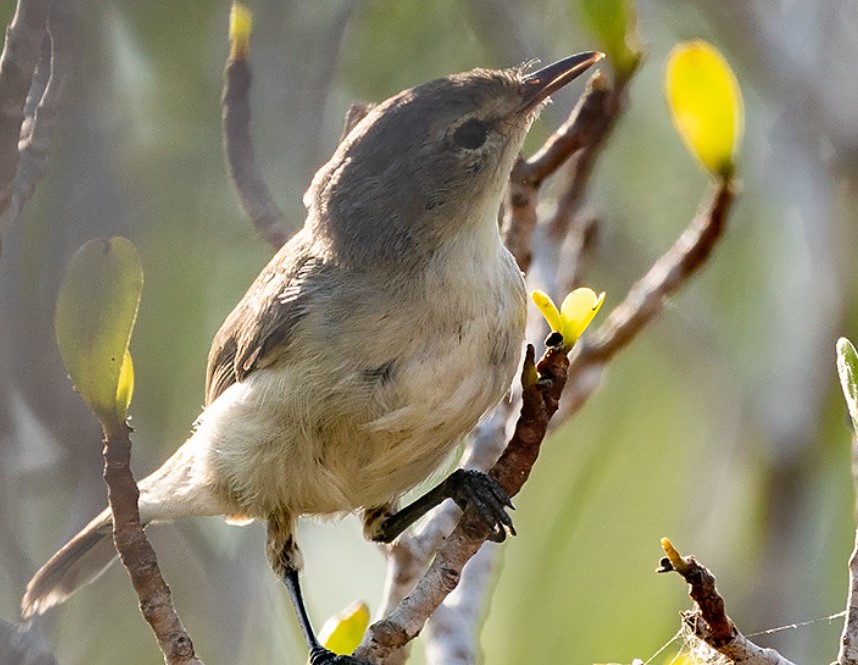DESCRIPTION: – The spotted pardalote (Pardalotus punctatus) is one of the most colorful and smallest birds in Australia, just 3.1 to 3.9 in (8 to 10 centimeters) in length and weighing is just 6 grams. This is a tiny white Jewel-like spot that adorns the crown, wings, and tail of the male Spotted Pardalote and the wings and tail of the female and because of these spots, the species is commonly called Diamond Bird.
The spotted pardalote has been assumed to be a Bassian derivative and the yellow-rumped pardalote an Eyrean derivative of their common ancestors, with spreading of both in a complicated manner. Like other pardalotes, it gleans for lerps, manna, and insects in the foliage of eucalypts, moving rapidly like a mouse through tree crowns, but it also differs in many of its habits.

Out of breeding, Spotted Pardalotes gather in loose feeding flocks of 10 to 20, or even 100 or so individuals, to forage nomadically. Most movements are generally local, but in the colder mountains of the southeast and Tasmania there is a general exodus to lowlands, inland, and northwards in autumn. Many groups reach the central Queensland coast then, a major non-breeding refuge for the species through winter. Also, the traveling groups keep contact with high mewing whistles as they move while feeding but not in flight. The flocks return and disperse with the onset of breeding.
Unlike Striated Pardalotes, individual pairs take up and defend much the same territory that encompasses the foraging range as well as the nest area. The male advertises it by singing frequently throughout the day from a bare vantage perch at mid-heights in trees. He stands high on his toes, head stretched erect and chin tucked in as each long note is uttered, turning to beam his voice in different directions. Both sexes-but mostly males-chase off intruders in long twisting flights and will attack planted models, pecking at the yellow throat patch. They themselves are in turn chased by larger pardalotes and, exclusively, honeyeaters.
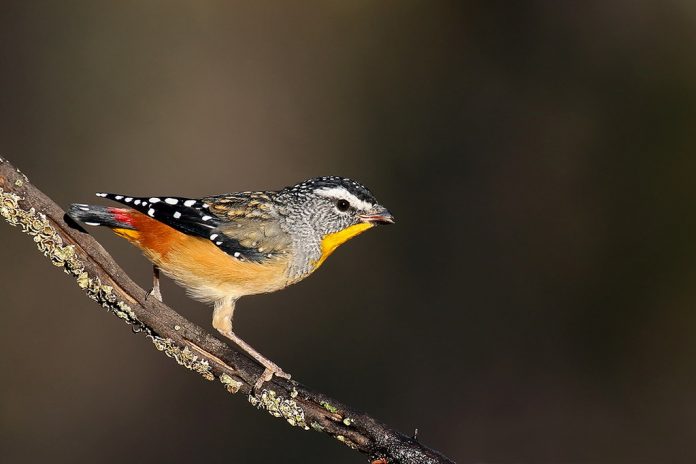
Spotted Pardalotes nest almost exclusively in terrestrial burrows excavated in low banks or walls. The male generally takes the initiative in selecting the site and both partners excavate and build the nest, occasionally breaking off to sit at the entrance and spread their wings in the display.
Both also share incubation and the feeding of young. Arriving birds dive into the nest hole in full flight. Two distinct forms of the Spotted Pardalote-one ochre-rumped in wet coastal forests and the other yellow-rumped in Mallee has often been regarded as separate species. They hybridize and intergrade from the Mt Lofty Ranges, SA, through the lower Murray mallee, to near Bendigo, Victoria.
On the high tablelands in northeastern Queensland is a third smaller race, its males blending the russet rumps of the wet forest race with the greyer, more finely spotted back of the mallee form. Although moderately common in all parts of Australia and three subspecies are recognized. The wet tropics spotted pardalote is found in northeastern Queensland, and the yellow-rumped pardalote is found in drier inland regions of southern Australia, particularly in semi-arid Mallee woodlands.
Read More – Red-browed Pardalote (Pardalotus rubricatus)
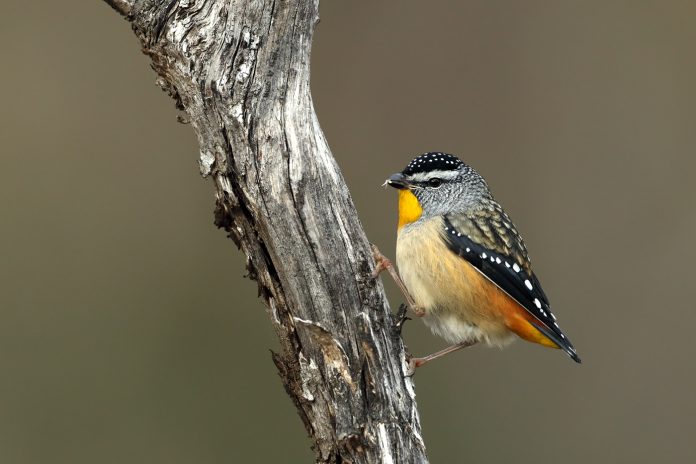
HABITATS: – The Spotted pardalote is the tiniest of the pardalotes and frequents denser, wetter eucalypt forests around temperate southern Australia, ranging north to the Atherton Tablelands along the Great Dividing Range where the climate is cool. Even where its yellow-rumped race ranges through Mallee, it keeps to the denser, wetter tracts with a close canopy. Not needing tree hollows for nesting, it is not limited to the mature forest and forages through saplings and regrowth, even to the ground, sites not often visited by Striated Pardalotes.
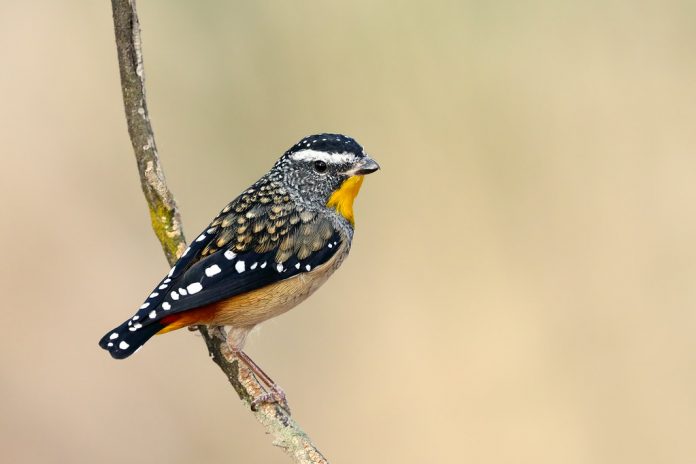
Read More – Spotted Pardalote (Pardalotus punctatus)
OTHER NAMES – Yellow-rumped Pardalote, Yellow-tailed Pardalote, Diamond Bird, Pardalote, Diamond Dyke, Ground Diamond, Spotted Diamond Bird.
IDENTIFICATION – The average length of spotted pardalote is about 90-100 mm. The Male bird’s crown is black, and spotted white; the hind neck is flecked gray. Mantle, scapular, and mid-back brown coarsely spotted buff to gray more finely spotted white; lower back and rump ochre-red to bright yellow, edged glossy crimson at the base over the tail.
The wings and tail are black, and the feathers tipped are white. Face flecked gray and white; long white eyebrow. Throat dark to bright yellow; breast and belly cream-buff to cream-white; under-tail dark to bright yellow. Eye grey-brown. The bill is black, grayish at the under base, and the feet are flesh brown.
FEMALE: As a male, but crown spots buff-yellow all races, back brown spotted coarsely to finely cream-buff all races; eyebrow huffier all races; throat cream-white.
IMMATURE: As female but crown olive-grey, spotted buff-yellow; dorsal spotting sparser; rump and undertail duller ochreish. Adult plumage gained at first annual molt.
BREED: – The Spotted Pardalote breeding season starts in mid-August and lasts till January. Male and female breed once a year, and the clutch contains three to four shiny white eggs, that are incubated for 20 days from hatching, and the chick takes another 22 days in the nest and then leaves it.
VOICE / CALL: Short series of mewing whistles, slower and dropping in short weep call and faster and rising in long weep call, given in contact. They do fast chipping in aggression at the nest and whistled wheee in alarm there. The young chick begs with short fast chirps.
SONG: The songs of males differ in the form of their elements their pitch and their temporal features, although the general structure of the songs and their quality are similar. Explosive, penetrating three or four-syllabled piping whistles by male: sa-weet ba-beee in ochre-rumped race, the second syllable high-piercing and the last longer draw; or wit wee-eee in the yellow-rumped race, in a simpler form and often with the first syllable elided.
NESTING – Nest a dome of loosely woven bark fiber and grass; sometimes lined with feathers; placed at the end of the sloping burrow, 500- 1500 mm long, excavated into creek bank, sandy ground, side of the cliff, and even wall of a building. Eggs: three to six, usually four; plain white; oval, about 16 x 13 mm. Incubation 1 4- 16 days, by both sexes.
DISTRIBUTION – Wet and dry sclerophyll forests and wetter mallee, infrequently more open woodland, around southern and eastern coastal and subcostal Australia, from Darling Ranges, WA, to Atherton Tableland, QLD.
Related Read – Band-tailed Barbthroat



